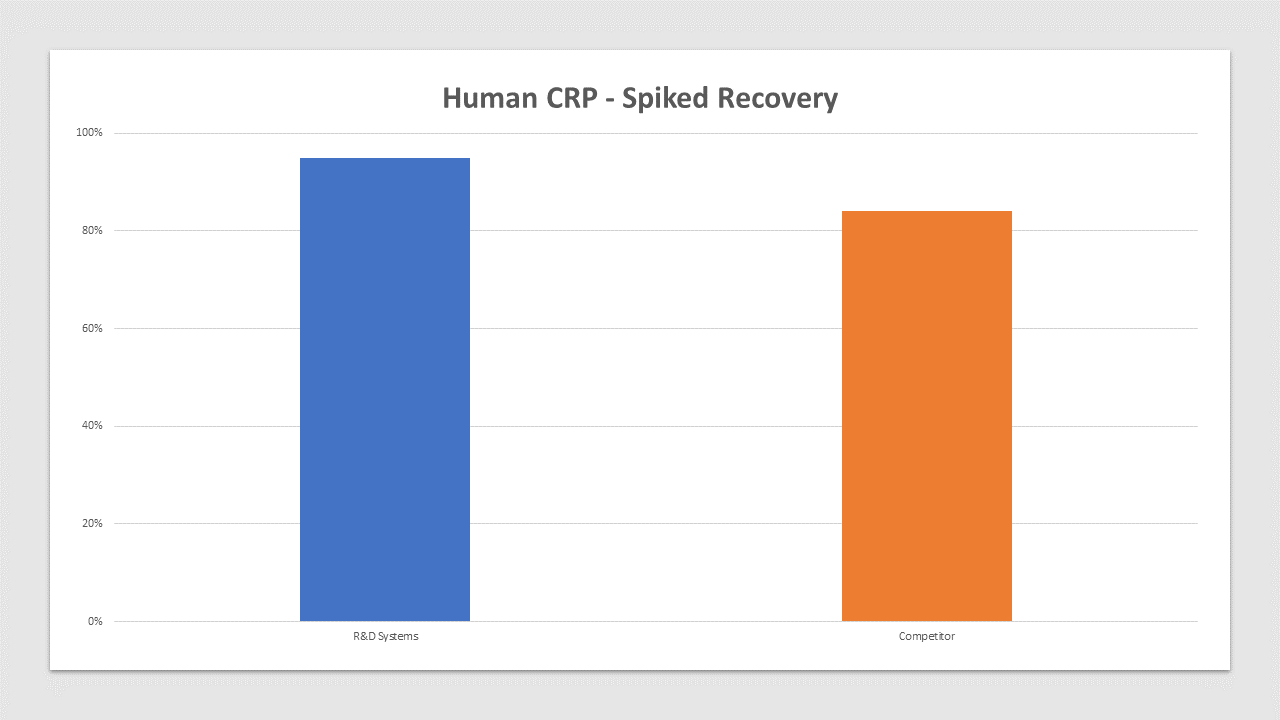Human C-Reactive Protein/CRP QuicKit ELISA Summary
Product Summary
Precision
Cell Culture Supernates, Serum, EDTA Plasma, Heparin Plasma
| Intra-Assay Precision | Inter-Assay Precision | |||
|---|---|---|---|---|
| Sample | 1 | 2 | 1 | 2 |
| n | 20 | 20 | 10 | 10 |
| Mean (ng/mL) | 3.75 | 26.1 | 4.03 | 24.8 |
| Standard Deviation | 0.146 | 1.08 | 0.195 | 1.31 |
| CV% | 3.9 | 4.1 | 4.8 | 5.3 |
Recovery
The recovery of human CRP spiked to three levels in samples throughout the range of the assay was evaluated.
| Sample Type | Average % Recovery | Range % |
|---|---|---|
| Cell Culture Media (n=4) | 96 | 92-102 |
Linearity
Scientific Data
 View Larger
View Larger
Human CRP QuicKit Spiked Recovery Competitor Comparison CRP is spiked at three known concentrations throughout the range of the assay and run to measure response of the spiked sample matrix. Culture media recovery is 95% compared to 84% for the top competitor. In spike and recovery experiments, natural samples are spiked with the recombinant target analyte of interest to identify interference caused by sample matrices.
Product Datasheets
Preparation and Storage
Background: C-Reactive Protein/CRP
C-Reactive Protein (CRP), also known as Pentraxin 1, is a non-glycosylated protein in the Pentraxin family that also includes Pentraxin 2/SAP and Pentraxin 3/TSG-14. CRP functions as a sensor and activator of the innate immune response (1). In humans, it is a major acute-phase protein; its circulating concentration is dramatically elevated at the onset of inflammation (2). In mice, however, serum CRP levels increase only slightly during inflammation, and the analogous acute phase role is filled by Pentraxin 2 (3). CRP assembles non-covalently into a 110-120 kDa cyclical pentamer (4). Mature human CRP shares 71% and 64% amino acid (aa) sequence identity with mouse and rat CRP, respectively (5). CRP binds and opsonizes apoptotic cells (6-8) as well as bacteria such as S. pneumoniae (9, 10). It subsequently enhances the phagocytosis of these opsonized cells (6, 8-10). CRP additionally binds several proteins in the complement cascade including C1q, C4BP, and Factor H (8, 11-13). It enhances activation of the classical complement pathway and the deposition of C3b (9). In later stages of the response, CRP inhibits complement-mediated cell lysis through its binding to C4BP and Factor H (8, 12). These interactions induce the upregulation of complement inhibitory proteins CD46, CD59, and CD55/DAF and inhibit assembly of the membrane attack complex (MAC) (8, 14). CRP binds to Fc gamma RI, Fc gamma RIIA, and Fc gamma RIIB on macrophages and dendritic cells (15-17), and Fc receptors are required for the phagocytosis of CRP-opsonized target cells (6, 10, 18). CRP binding to Fc gamma RI induces Src activation which subsequently triggers the inhibitory Fc gamma RIIb and dampens the inflammatory response (15, 19). CRP additionally promotes dendritic cell maturation and humoral immunity (10). In cardiovascular disease, CRP binds to oxidized LDL, exacerbates tissue damage in coronary artery infarction, and inhibits the repair of injured vascular endothelium (7, 19, 20).
Assay Procedure
These assays utilize an anti-tag coated microplate. Standards, samples, and controls are added to plate, followed by subsequent addition of an antibody cocktail. Following a 1 hour incubation, plates are washed and substrate is added and incubated for 20 minutes. Stop solution is then added and plates are read using a standard microplate reader.

FAQs
No product specific FAQs exist for this product, however you may
View all ELISA FAQsReviews for Human C-Reactive Protein/CRP QuicKit ELISA
There are currently no reviews for this product. Be the first to review Human C-Reactive Protein/CRP QuicKit ELISA and earn rewards!
Have you used Human C-Reactive Protein/CRP QuicKit ELISA?
Submit a review and receive an Amazon gift card.
$25/€18/£15/$25CAN/¥75 Yuan/¥2500 Yen for a review with an image
$10/€7/£6/$10 CAD/¥70 Yuan/¥1110 Yen for a review without an image




